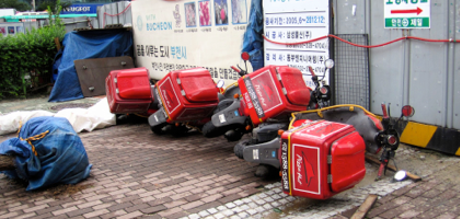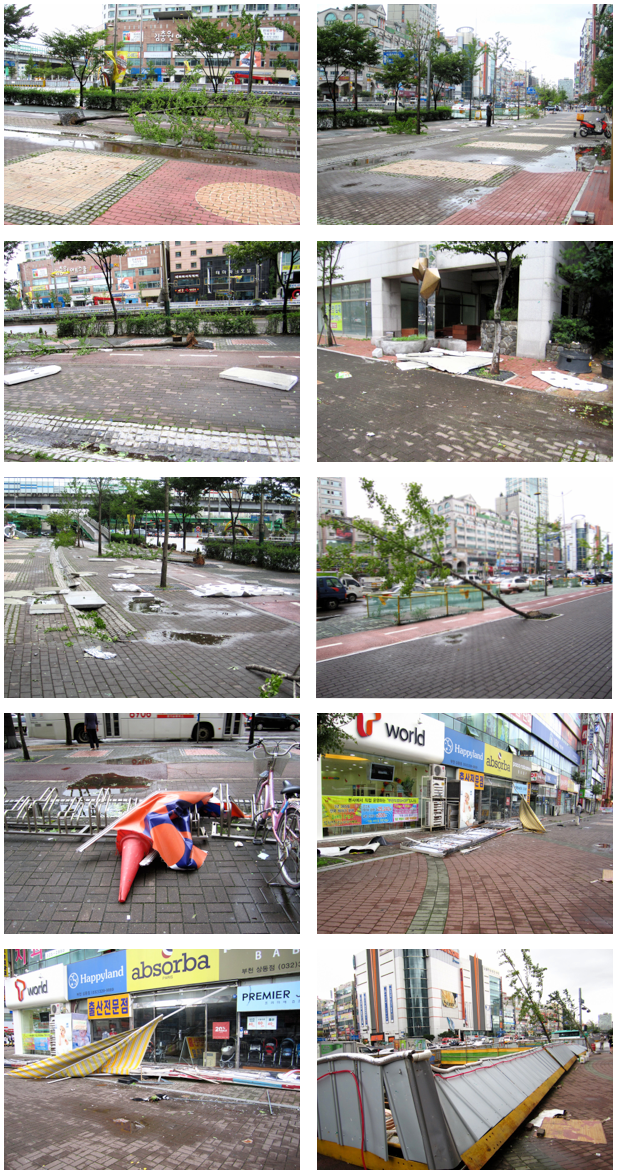
03/09/2010
W nocy z środy na czwartek dotarł do nas tajfun. W hotelu jak w bunkrze więc bezpiecznie ale tajfun było slychać i to dosyć głośno, wicher i deszcz. Piotrek przespał tajfun i nic nie słyszał. Rano w czwartek jeszcze było trochę wietrznie ale szybko się uspokoiło i po południu już było słonecznie. Rano można było zobaczyć szkody wyrządzone przez tajfun, zanim zdąrzyli je posprzątać. Nie były jakieś poważne, przynajmniej w naszej okolicy. Trochę mniejszych drzew powyrywanych z korzeniami, jakieś wielkie śmieci gdzieniegdzie, no i widziałam reklama jedna wielką która spadła na chodnik z wyskości.
Tajfun to lokalna nazwa cyklonów tropikalnych używana we wschodniej i południowo wschodniej Azji. W tajfunie występuje tzw. oko cyklonu, w którym panuje spokój i nie pada deszcz ani nie ma wiatru. Tajfuny występują w porze letniej i jesiennej, wiatry osiągają ogromne prędkości, niosą ze sobą obfite opady desczu i bardzo często powodują straty.
Słowo tajfun wywodzi się z chińskiego 台风 (táifēng) i oznacza "wiatr z Tajwanu”.
Tajfun czwartkowy nazywał się Kompasu i był siódmym w tym roku w Korei południowej. Z tego co czytałam to są dwie ofiary śmiertelne. Sparaliżował Seoul i cały system metra.
Meteorolodzy mówią że Kompasu to najsilniejszy tajfun który uderzył w Seul i okolice od 15 lat. Kompasu osiągnął prędkość około 30 m/sek.
W czwartek rano udało mi się zrobić kilka zdjęć bałaganu jaki zostawił po sobie Kompasu:
On Wednesday night a typhoon swept through the area north of Seoul. Our hotel is like a bunker so we were safe ;) but I could hear it during the night, the wind and rain, and it was pretty noisy. Piotr slept through and didn’t hear a thing. On Thursday morning it was still a bit windy but it died down pretty quickly and it was sunny in the afternoon. I could see the damage done by the typhoon, before it was cleaned up. There wasn’t a lot of big damage, at least around the hotel, just a few smaller trees uprooted, some rubbish scattered around, and I saw one big business sign that fell down on the pavement.
Typhoon is a local name for tropical cyclone, used in east and south east Asia. In the middle of a typhon there is an eye of a cyclone, where it is very quiet, no rain and no wind. Typhoons
appear in the summer and autumn, and the wind can get to a very high speed, bringing heavy rainfalls and often causing a lot of damage.
The word typhoon comes from Chinese 台风 (táifēng) and means wind from Taiwan.
Last night's typhoon was called Kompasu and it was the 7th one this year in South Korea. From what I read on the internet there are 2 dead, and the whole Seoul subway system came to a standstill. Meteorologists said that Kompasu was the strongest typhoon that hit Seoul and areas for 15 years. Kompasu winds got up to 30 m per second in speed.
I managed to take a few photos of the mess Kompasu made in our area:

